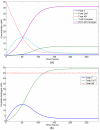The evolutionary impact of androgen levels on prostate cancer in a multi-scale mathematical model
- PMID: 20406442
- PMCID: PMC2885348
- DOI: 10.1186/1745-6150-5-24
The evolutionary impact of androgen levels on prostate cancer in a multi-scale mathematical model
Abstract
Background: Androgens bind to the androgen receptor (AR) in prostate cells and are essential survival factors for healthy prostate epithelium. Most untreated prostate cancers retain some dependence upon the AR and respond, at least transiently, to androgen ablation therapy. However, the relationship between endogenous androgen levels and cancer etiology is unclear. High levels of androgens have traditionally been viewed as driving abnormal proliferation leading to cancer, but it has also been suggested that low levels of androgen could induce selective pressure for abnormal cells. We formulate a mathematical model of androgen regulated prostate growth to study the effects of abnormal androgen levels on selection for pre-malignant phenotypes in early prostate cancer development.
Results: We find that cell turnover rate increases with decreasing androgen levels, which may increase the rate of mutation and malignant evolution. We model the evolution of a heterogeneous prostate cell population using a continuous state-transition model. Using this model we study selection for AR expression under different androgen levels and find that low androgen environments, caused either by low serum testosterone or by reduced 5alpha-reductase activity, select more strongly for elevated AR expression than do normal environments. High androgen actually slightly reduces selective pressure for AR upregulation. Moreover, our results suggest that an aberrant androgen environment may delay progression to a malignant phenotype, but result in a more dangerous cancer should one arise.
Conclusions: The model represents a useful initial framework for understanding the role of androgens in prostate cancer etiology, and it suggests that low androgen levels can increase selection for phenotypes resistant to hormonal therapy that may also be more aggressive. Moreover, clinical treatment with 5alpha-reductase inhibitors such as finasteride may increase the incidence of therapy resistant cancers.
Figures













Similar articles
-
Steroidogenic enzyme AKR1C3 is a novel androgen receptor-selective coactivator that promotes prostate cancer growth.Clin Cancer Res. 2013 Oct 15;19(20):5613-25. doi: 10.1158/1078-0432.CCR-13-1151. Epub 2013 Aug 30. Clin Cancer Res. 2013. PMID: 23995860
-
Regulation of FGF8 expression by the androgen receptor in human prostate cancer.Oncogene. 2002 Aug 1;21(33):5069-80. doi: 10.1038/sj.onc.1205663. Oncogene. 2002. PMID: 12140757
-
5alpha-androstane-3alpha,17beta-diol supports human prostate cancer cell survival and proliferation through androgen receptor-independent signaling pathways: implication of androgen-independent prostate cancer progression.J Cell Biochem. 2008 Aug 1;104(5):1612-24. doi: 10.1002/jcb.21731. J Cell Biochem. 2008. PMID: 18320593
-
Androgen action in the prostate gland.Minerva Urol Nefrol. 2012 Mar;64(1):35-49. Minerva Urol Nefrol. 2012. PMID: 22402316 Review.
-
Key targets of hormonal treatment of prostate cancer. Part 1: the androgen receptor and steroidogenic pathways.BJU Int. 2009 Aug;104(4):438-48. doi: 10.1111/j.1464-410X.2009.08695.x. Epub 2009 Jun 24. BJU Int. 2009. PMID: 19558559 Review.
Cited by
-
A Small Peptide Targeting the Ligand-Induced Androgen Receptor/Filamin a Interaction Inhibits the Invasive Phenotype of Prostate Cancer Cells.Cells. 2021 Dec 22;11(1):14. doi: 10.3390/cells11010014. Cells. 2021. PMID: 35011576 Free PMC article.
-
Evolution and cancer: a mathematical biology approach.Biol Direct. 2010 Apr 20;5:29. doi: 10.1186/1745-6150-5-29. Biol Direct. 2010. PMID: 20406450 Free PMC article. No abstract available.
-
Quantitative mathematical modeling of PSA dynamics of prostate cancer patients treated with intermittent androgen suppression.J Mol Cell Biol. 2012 Jun;4(3):127-32. doi: 10.1093/jmcb/mjs020. Epub 2012 May 4. J Mol Cell Biol. 2012. PMID: 22561841 Free PMC article.
-
Practical Understanding of Cancer Model Identifiability in Clinical Applications.Life (Basel). 2023 Feb 1;13(2):410. doi: 10.3390/life13020410. Life (Basel). 2023. PMID: 36836767 Free PMC article.
-
A multiscale, mechanism-driven, dynamic model for the effects of 5α-reductase inhibition on prostate maintenance.PLoS One. 2012;7(9):e44359. doi: 10.1371/journal.pone.0044359. Epub 2012 Sep 6. PLoS One. 2012. PMID: 22970204 Free PMC article.
References
-
- Dobzhansky T. Nothing in biology makes sense except in the light of evolution. Am Biol Teacher. 1973;35:125–129.
-
- Greaves M. Cancer: the evolutionary legacy. Oxford University Press, Oxford; 2000.
Publication types
MeSH terms
Substances
Grants and funding
LinkOut - more resources
Full Text Sources
Medical
Research Materials

